|
|
|
Sort Order |
|
|
|
Items / Page
|
|
|
|
|
|
|
| Srl | Item |
| 1 |
ID:
160990


|
|
|
|
|
| Summary/Abstract |
With the continued use of unsafeguarded naval nuclear-propulsion programs in all nuclear-weapon states, the commissioning of an Indian nuclear submarine, and the potential investment in such programs by non-nuclear-weapon states including Brazil and South Korea, movement toward a regulatory regime for nuclear material in the naval sector has become imperative. Such a framework faces a recurring debate on adequately protecting sensitive military technology while delivering assurances that naval nuclear material is not diverted to nuclear-weapon programs. In this viewpoint, we examine various prospective mechanisms to regulate naval nuclear stocks and assess them in terms of their effectiveness and scope. Drawing on lessons from the drafting, negotiation, and implementation of the Model Additional Protocol, we recommend a safeguards regime for naval nuclear material via a protocol that supplements the existing global nuclear-governance system. This protocol provides a standardized yet flexible approach to naval nuclear-material safeguards across all states (whether nuclear-weapon states, non-nuclear-weapon states, or outside the Treaty on the Non-Proliferation of Nuclear Weapons) to handle variations among naval nuclear fuel cycles and technologies.
|
|
|
|
|
|
|
|
|
|
|
|
|
|
|
|
| 2 |
ID:
104162
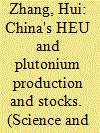

|
|
|
|
|
| Publication |
2011.
|
| Summary/Abstract |
This article discusses the history of China's production of highly enriched uranium and plutonium for nuclear weapons and uses new public information to estimate the amount of highly enriched uranium and plutonium China produced at its two gaseous diffusion plants and two plutonium production complexes. The new estimates in this article are that China produced 20 ± 4 tons of HEU, 2 ± 0.5 tons of plutonium, and currently has stockpiles of about 16 ± 4 tons of HEU and 1.8 ± 0.5 tons of plutonium available for weapons. The values for China's fissile material production are at the low end of most previous independent estimates, which range from 17-26 tons of highly enriched uranium and 2.1-6.6 tons of plutonium. These new estimates would be significant to assess China's willingness to join a fissile material cutoff treaty and a multilateral nuclear disarmament.
|
|
|
|
|
|
|
|
|
|
|
|
|
|
|
|
| 3 |
ID:
127633
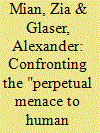

|
|
|
|
|
| Publication |
2014.
|
| Summary/Abstract |
Nuclear weapon states historically have attached great secrecy to their nuclear weapon and fissile material production programs and stockpiles, despite warnings that this would fuel fears, handicap informed debate and decision making, and drive arms races. As evidenced by the "Action Plan on Nuclear Disarmament" agreed upon at the 2010 Treaty on the Non-Proliferation of Nuclear Weapons (NPT) Review Conference, however, the international community now sees greater transparency about nuclear weapon and fissile material stocks as necessary for enabling and monitoring progress toward nuclear disarmament. To support this effort, the International Panel on Fissile Materials has proposed a step-by-step program for weapon states to declare their inventories, production histories, and disposition of nuclear warheads and fissile materials, and to set up joint projects to develop methods for verifying these declarations. This openness initiative is described here, and could be adopted at the 2015 NPT Review Conference, laying a basis for negotiating verifiable deep reductions in nuclear arsenals and their eventual elimination.
|
|
|
|
|
|
|
|
|
|
|
|
|
|
|
|
| 4 |
ID:
111133
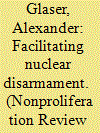

|
|
|
|
|
| Publication |
2012.
|
| Summary/Abstract |
Unprecedented interest in seeking progress toward nuclear disarmament exists today; even some nuclear weapon states are looking for new ways to strengthen this process. National declarations of fissile material holdings-highly enriched uranium and plutonium-could play an important role in supporting this effort, facilitating not only transparency but also the irreversibility of the process. This article discusses what kind of content such declarations could have in order to be meaningful and effective, the sequence of data on fissile material holdings that states might release, and some of the challenges to be expected in reconstructing historic fissile material production; it also summarizes current attitudes of weapon states toward making such declarations. Initial declarations can be valuable as confidence-building measures, but better and more background data are necessary if declarations are to serve as the groundwork for deeper cuts in the nuclear arsenals. A robust verification approach would ultimately require inspectors to have access to fissile material production and storage sites. The methods and tools of nuclear forensic analysis-in this context also dubbed nuclear archaeology-would be a key element of this process. This article discusses the capabilities and limitations of potential approaches to verifying declarations of historic production of plutonium and highly enriched uranium; it also identifies and discusses opportunities for further research and development.
|
|
|
|
|
|
|
|
|
|
|
|
|
|
|
|
| 5 |
ID:
118123
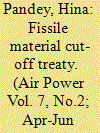

|
|
|
| 6 |
ID:
082428
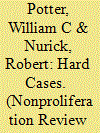

|
|
|
|
|
| Publication |
2008.
|
| Summary/Abstract |
Many countries received Soviet-origin highly enriched uranium (HEU) for civilian nuclear research purposes. Because of inadequate nuclear security at a number of the research sites, U.S. policy has sought to remove or otherwise safely dispose of their HEU stocks as quickly as possible. Although the pace of HEU disposition has accelerated significantly in recent years, several sites have posed formidable technical, economic, and political challenges. This article identifies the major obstacles to HEU removal at two key installations-Kharkiv in Ukraine, and Sosny in Belarus-and recommends a strategy for overcoming these impediments. Key components for a successful disposition strategy include: treating these cases with the urgency they deserve, expanding potential compensation packages, explicitly addressing the institutional and political issues involved, engaging high-level political leaders, working with third parties, and promoting these efforts as part of a nondiscriminatory initiative to phase out HEU in the civilian nuclear sector globally.
|
|
|
|
|
|
|
|
|
|
|
|
|
|
|
|
| 7 |
ID:
082429
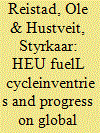

|
|
|
|
|
| Publication |
2008.
|
| Summary/Abstract |
In 2007, 334 nuclear reactors (including for naval propulsion) and isotope production facilities employed highly enriched uranium (HEU) fuel or target material. One year of operations at these reactors and facilities required more than 3,100 kilograms (kg) of HEU for naval propulsion, more than 750 kg for research reactors, and 40?-50 kg for isotope production in civilian facilities-in addition to several tons used in other types of reactors. Material with high enrichment levels and low radiation barriers stored or handled in large batches, such as HEU target waste and certain types of fuel from isotope production, research reactors/critical assemblies, and naval fuel, presents serious safety and security concerns. Forty-eight civilian research reactors have converted to low-enriched uranium as a result of a three-decade international effort to minimize HEU use, resulting in a decrease in HEU consumption of 278 kg per year. This article's establishment of baseline measurements for assessing the results of HEU minimization efforts calls for additional focus on the scope and methodology of HEU minimization. Facility decommissioning and dismantling should play a larger role in the future HEU minimization effort, materials with specific weapons-relevant properties should be given higher priority compared to bulk HEU material, and the use of large quantities of weapon-grade HEU fuel for naval propulsion should be reconsidered.
|
|
|
|
|
|
|
|
|
|
|
|
|
|
|
|
| 8 |
ID:
167796
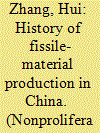

|
|
|
|
|
| Summary/Abstract |
This article reconstructs the history of China’s production of highly enriched uranium and plutonium for nuclear weapons based on newly available public sources. It begins with discussion of China’s first set of fissile-material production facilities, which China started building in 1958. It then details the first and second “third-line” construction campaigns, initiated in 1964 and the late 1960s, respectively. Finally, the article considers the policy implications of the history of China’s fissile-material production, particularly its influence on China’s attitude toward negotiating a fissile-material cutoff treaty.
|
|
|
|
|
|
|
|
|
|
|
|
|
|
|
|
| 9 |
ID:
104161
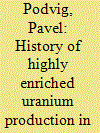

|
|
|
| 10 |
ID:
099514
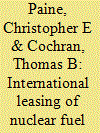

|
|
|
|
|
| Publication |
2010.
|
| Summary/Abstract |
Current International Atomic Energy Agency safeguards do not provide adequate protection against the diversion to military use of materials or technology from certain types of sensitive nuclear fuel cycle facilities. In view of highly enriched uranium's relatively greater ease of use as a nuclear explosive material than plutonium and the significant diseconomies of commercial spent fuel reprocessing, this article focuses on the need for improved international controls over uranium enrichment facilities as the proximate justification for creation of an International Nuclear Fuel Cycle Association (INFCA). In principle, the proposal is equally applicable to alleviating the proliferation concerns provoked by nuclear fuel reprocessing plants and other sensitive nuclear fuel cycle facilities. The INFCA would provide significantly increased nonproliferation assurance to its member states and the wider international community by holding long-term leasehold contracts to operate secure restricted zones containing such sensitive nuclear facilities.
|
|
|
|
|
|
|
|
|
|
|
|
|
|
|
|
| 11 |
ID:
082425
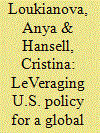

|
|
|
|
|
| Publication |
2008.
|
| Summary/Abstract |
.S. leadership has been the driving force behind reducing the civilian use of highly enriched uranium (HEU). By tracing the history of linkages between U.S. HEU policies at home and abroad, this paper examines the reasons why the U.S.-led Reduced Enrichment for Research and Test Reactors (RERTR) and HEU removal programs, despite great technical successes, have not led to quicker elimination of weapon-grade uranium. It argues that the United States must take urgent steps domestically and internationally in order to achieve global elimination of the use of HEU in the civilian sphere. Washington must restore consistency of HEU policy by rescinding the Burr Amendment and consider reductions in the U.S. military stockpile as a means of signaling its commitment. U.S. leaders must also find more creative ways to engage countries and individual facilities in HEU minimization and to extend the norm against HEU use worldwide
|
|
|
|
|
|
|
|
|
|
|
|
|
|
|
|
| 12 |
ID:
152066
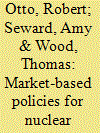

|
|
|
|
|
| Summary/Abstract |
Access to weapon-useable fissile material—highly enriched uranium and separated plutonium—is the primary technical barrier to nuclear-weapon development. Nuclear-nonproliferation policy is largely concerned with the secure distribution and use of these materials and the technologies that produce them. To the extent that both materials and technologies are traded in markets, the problem may be viewed as one of influencing markets to give an acceptable set of allocative outcomes. While governments long ago rejected a laissez-faire approach to these markets, most current policy is based on prescribed or proscribed behavior rather than market incentives. “Market-based” nonproliferation policies would act through incentives in the markets for nuclear materials and technology rather than by prescribing outcomes or behavior. Possible polices of this sort include subsidized enrichment services, credits to impute value to spent nuclear fuel, and new markets for scarce nuclear materials. While market-based policies will not replace command-and-control policies entirely, they could lead to efficient regulation that suffices to guide the choices of most market participants, reserving special, more forceful measures for the few difficult cases.
|
|
|
|
|
|
|
|
|
|
|
|
|
|
|
|
| 13 |
ID:
144817
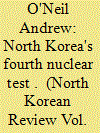

|
|
|
| 14 |
ID:
150286
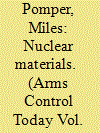

|
|
|
|
|
| Summary/Abstract |
When Russian troops intervened in Crimea in 2014 and sparked a crisis over Ukraine, global tensions spiked. Thanks to the nuclear security summit process initiated by President Barack Obama, there was at least one worry that no longer troubled White House officials: the presence of highly enriched uranium (HEU) in Ukraine that might have given leaders in Kiev a nuclear weapons option.
|
|
|
|
|
|
|
|
|
|
|
|
|
|
|
|
| 15 |
ID:
082426
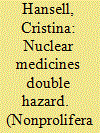

|
|
|
|
|
| Publication |
2008.
|
| Summary/Abstract |
This article examines the production of metastable technetium-99 (Tc-99m), the world's most important radiopharmaceutical, focusing on reliability of supply and risks of nuclear terrorism. Only four producers manufactured about 95 percent of the world's Tc-99m; a closure of any of them could cause worldwide shortfalls. Moreover, all four employ highly enriched uranium in their production process, in a form relatively easy to convert into the metal needed for a nuclear bomb. The technology to employ low-enriched uranium (LEU)-not usable in weapons-to produce Tc-99m is proven, available, and has been used by smaller producers. However, political determination and sufficient funding are needed to convert the major producers' isotope production to LEU and encourage new LEU-based production. Such efforts are needed to ensure supplies and reduce security risks.
|
|
|
|
|
|
|
|
|
|
|
|
|
|
|
|
| 16 |
ID:
082424
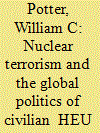

|
|
|
|
|
| Publication |
2008.
|
| Summary/Abstract |
An increasing number of countries recognize the special risks of nuclear terrorism associated with the civilian use and storage of and commerce in highly enriched uranium (HEU). They are especially concerned that non-state actors might gain access to HEU and use it to build and detonate improvised nuclear devices. The risk is aggravated by the very large global stocks of HEU, some of which are inadequately protected. Although HEU has few commercial uses, and most experts believe it is technically feasible to substitute low-enriched uranium for HEU in nearly all civilian applications, efforts to reduce HEU stocks have been impeded by a variety of economic, political, and strategic considerations. This article analyzes the nature of these impediments and discusses what is required to overcome them
|
|
|
|
|
|
|
|
|
|
|
|
|
|
|
|
| 17 |
ID:
149609
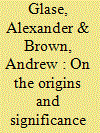

|
|
|
|
|
| Summary/Abstract |
The International Atomic Energy Agency (IAEA) defines uranium with a 235U isotope concentration of 20 percent as the threshold between low-enriched uranium (LEU) and highly enriched uranium (HEU), and as a significant waypoint on the path towards weapon-grade uranium (typically above 90 percent 235U enrichment). The distinction between LEU and HEU is widely used in shaping nonproliferation policy, and it has featured prominently in commentary over Iran's nuclear program and the series of Nuclear Security Summits that since 2010 have sought to minimize civilian stockpiles and use of HEU. Yet the origin of this threshold is obscure, dating back 6 decades. This research note traces the political origin and the technical basis for this limit.
|
|
|
|
|
|
|
|
|
|
|
|
|
|
|
|
| 18 |
ID:
082427
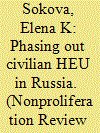

|
|
|
|
|
| Publication |
2008.
|
| Summary/Abstract |
Russia holds the largest stocks of civilian highly enriched uranium (HEU) of any country, operating more than fifty research reactors, pulsed reactors, and critical assemblies using HEU, as well as nine HEU-fueled icebreakers. Russia's participation in international efforts to phase out civilian HEU is crucial if international HEU minimization efforts are to succeed. Individual Russian institutes and organizations participate in international programs to replace HEU with low-enriched uranium in Soviet-supplied research reactors, develop alternative fuels, and repatriate fresh and spent HEU fuel from third countries. However, an overarching national policy on HEU phase-out has yet to be adopted. There are many obstacles to obtaining such a commitment from Moscow. At the same time, the ongoing reform of the Russian nuclear industry and plans for expansion of domestic nuclear power generation and for increased nuclear exports create opportunities for securing such a commitment
|
|
|
|
|
|
|
|
|
|
|
|
|
|
|
|
| 19 |
ID:
082430
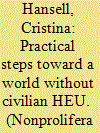

|
|
|
|
|
| Publication |
2008.
|
| Summary/Abstract |
In the last three decades, the Reduced Enrichment Research and Test Reactors program has made great progress in developing the technical means to eliminate HEU use in most civilian applications. Yet in practice, this has not translated into significant global reductions in HEU use. This article identifies steps to build the international consensus needed to reduce the risks posed by HEU. Immediate steps include devising new incentives for reactor shutdown and conversion; establishing research reactor coalitions; launching a global HEU database; giving the International Atomic Energy Agency a mandate to promote HEU minimization; and improving physical protection standards. Intermediate measures include the adoption of HEU management guidelines and a code of conduct. Further, national governments should pass laws phasing out domestic use of HEU and conditioning HEU exports on conversion commitments. In the long term, international legal measures must be adopted to eliminate the risks posed by HEU.
|
|
|
|
|
|
|
|
|
|
|
|
|
|
|
|
| 20 |
ID:
166863
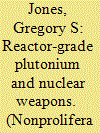

|
|
|
|
|
| Summary/Abstract |
The claim that reactor-grade plutonium cannot or will not be used to produce nuclear weapons has been used to justify non-nuclear-weapon states’ large stockpiles of plutonium that has been separated from highly radioactive spent fuel. However, by using reduced-mass plutonium cores, it is possible to manufacture reliable nuclear weapons with reactor-grade plutonium. These weapons can have the same design, size, weight, and predetonation probability as weapons using weapon-grade plutonium and would require no special cooling. The increased radiation from reactor-grade plutonium could be easily managed by shielding and operational procedures. Weapons using plutonium routinely produced by pressurized-water reactors could have a lethal area between 40 percent and 75 percent that of weapons using weapon-grade plutonium. In the past, both Sweden and Pakistan considered using reactor-grade plutonium to produce nuclear weapons, and India may be using reactor-grade plutonium in its arsenal today. Despite claims to the contrary, the United States used what was truly reactor-grade plutonium in a successful nuclear test in 1962. The capability of reactor-grade plutonium to produce highly destructive nuclear weapons leads to the conclusion that the separation of plutonium, plutonium stockpiling, and the use of plutonium-based fuels must be phased out and banned.
|
|
|
|
|
|
|
|
|
|
|
|
|
|
|
|
|
|
|
|
|